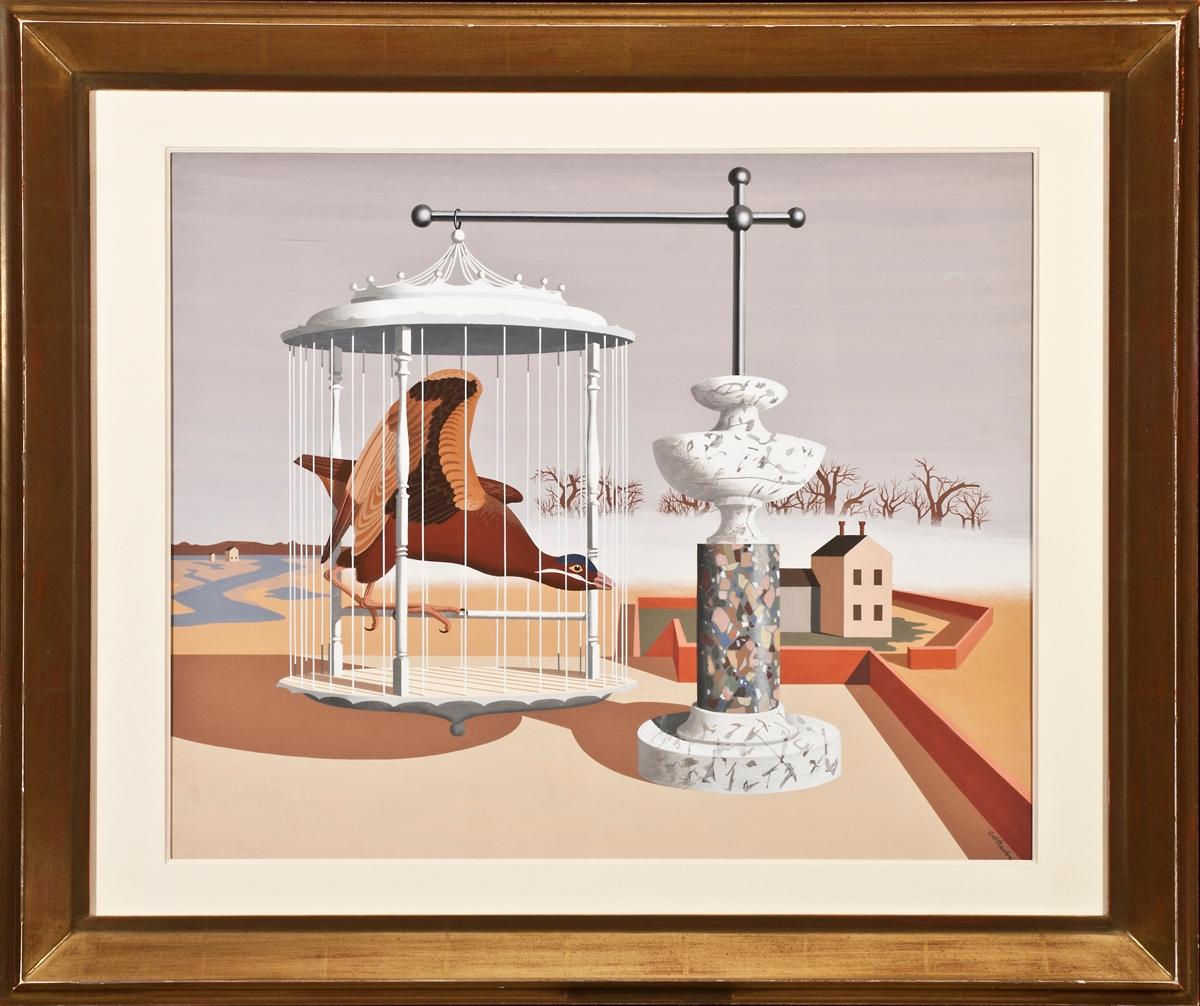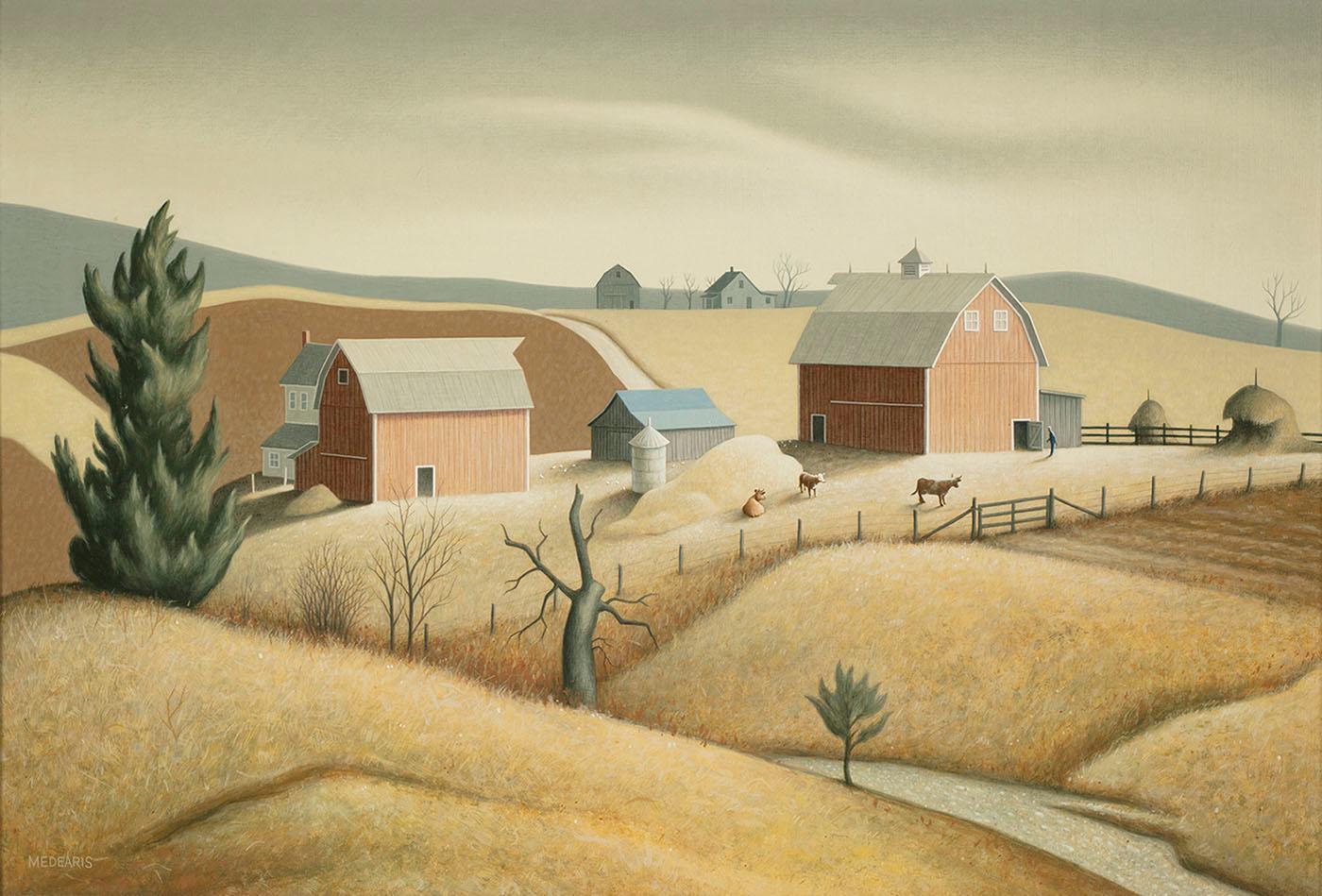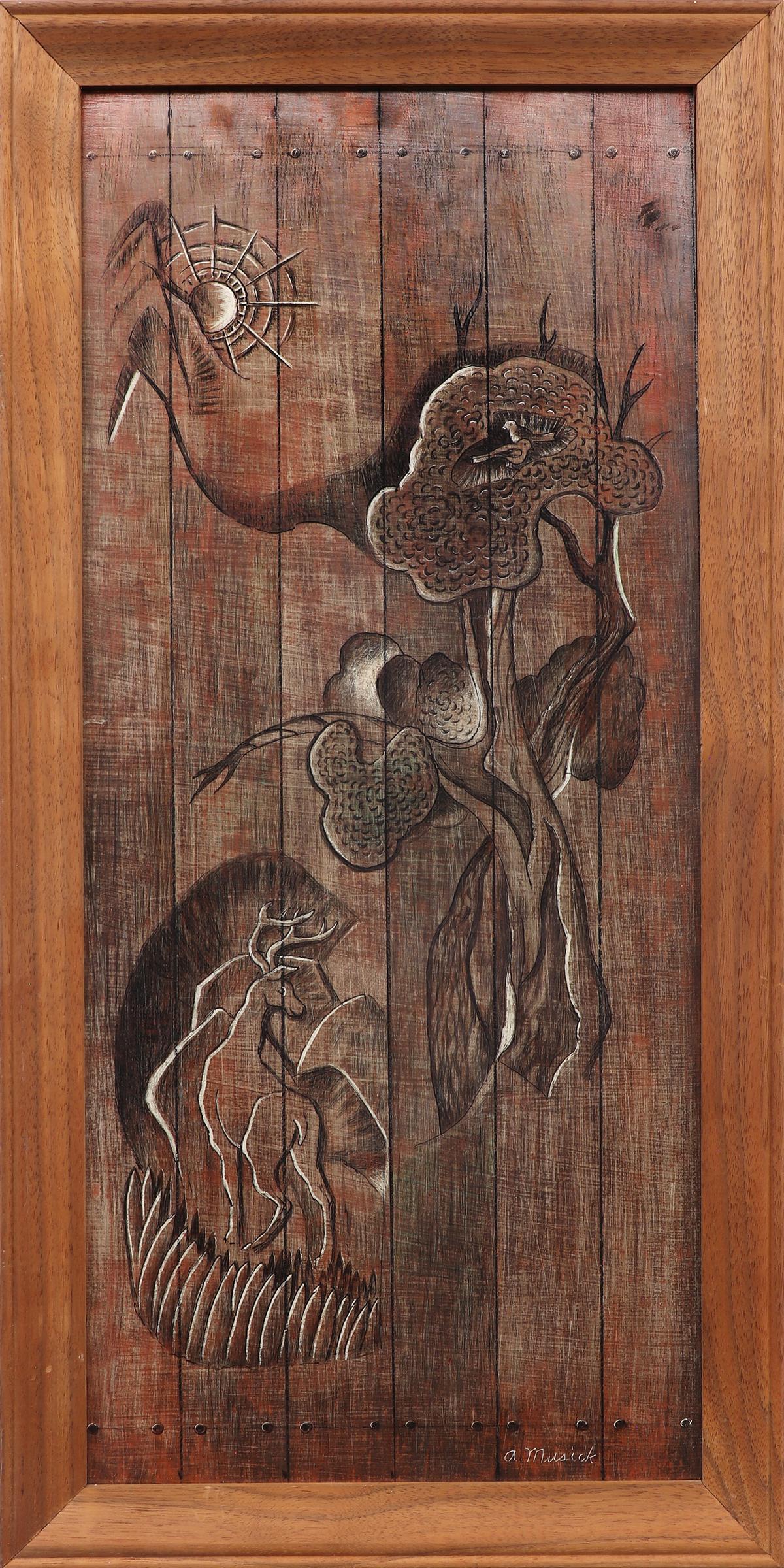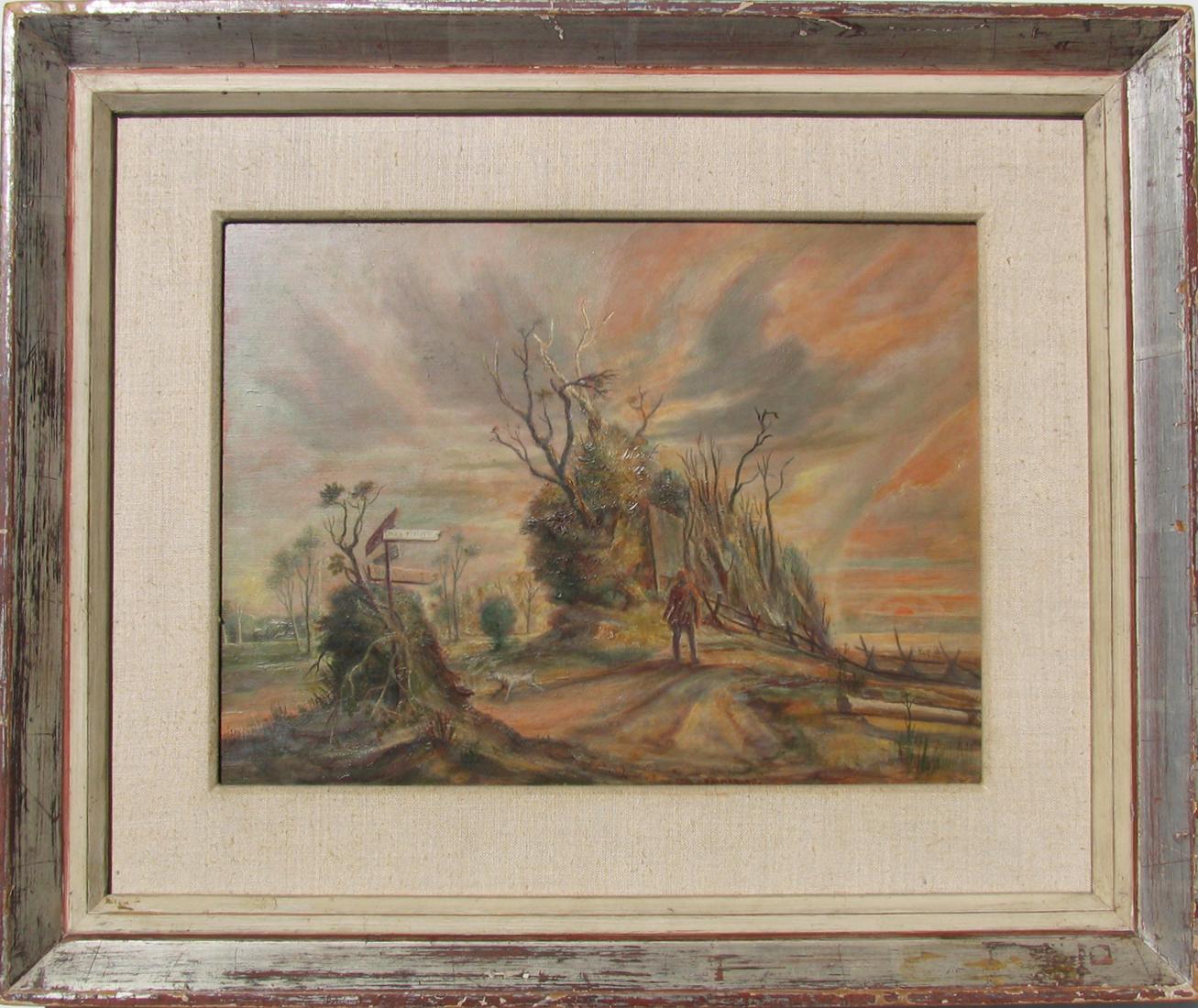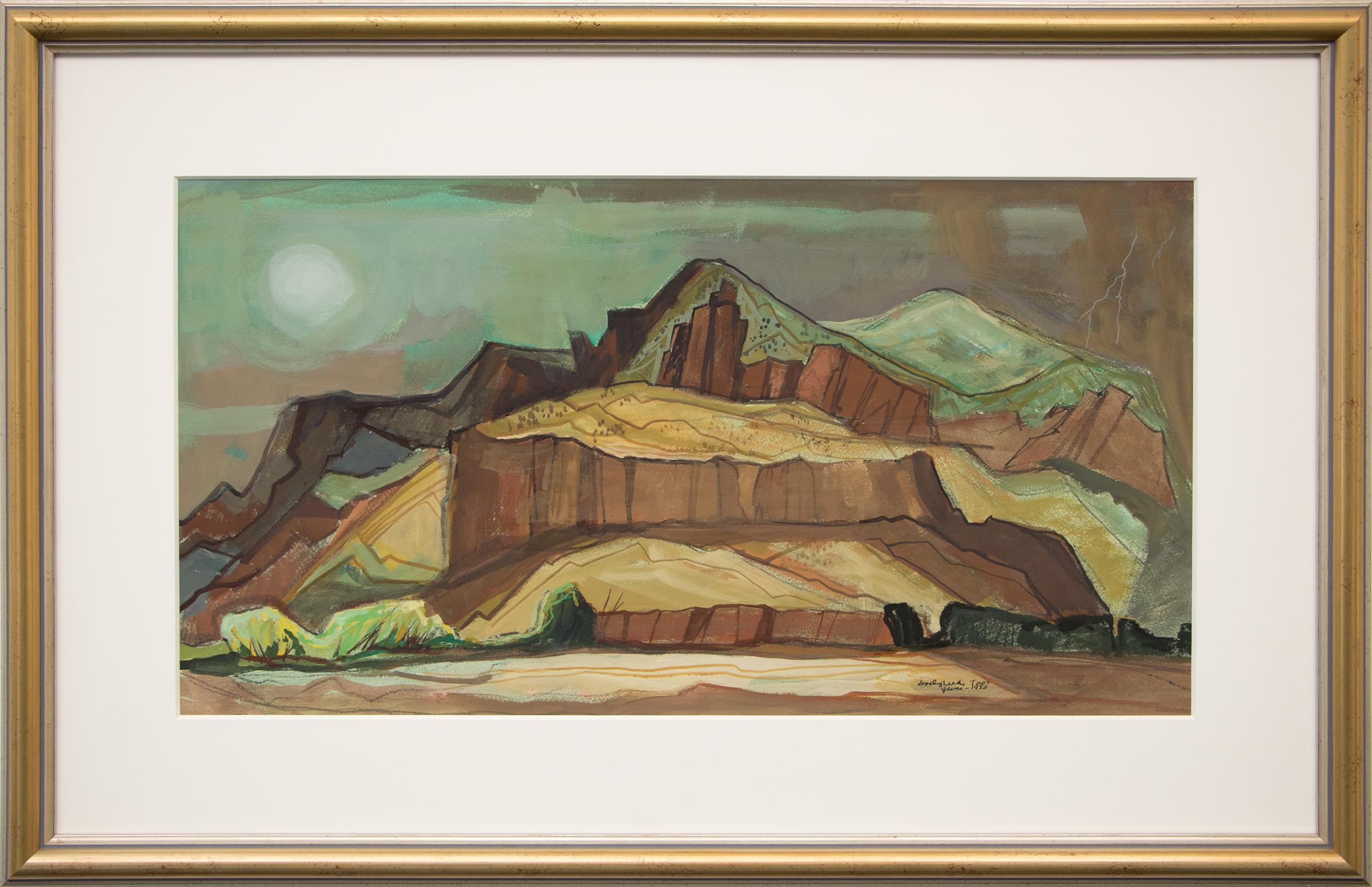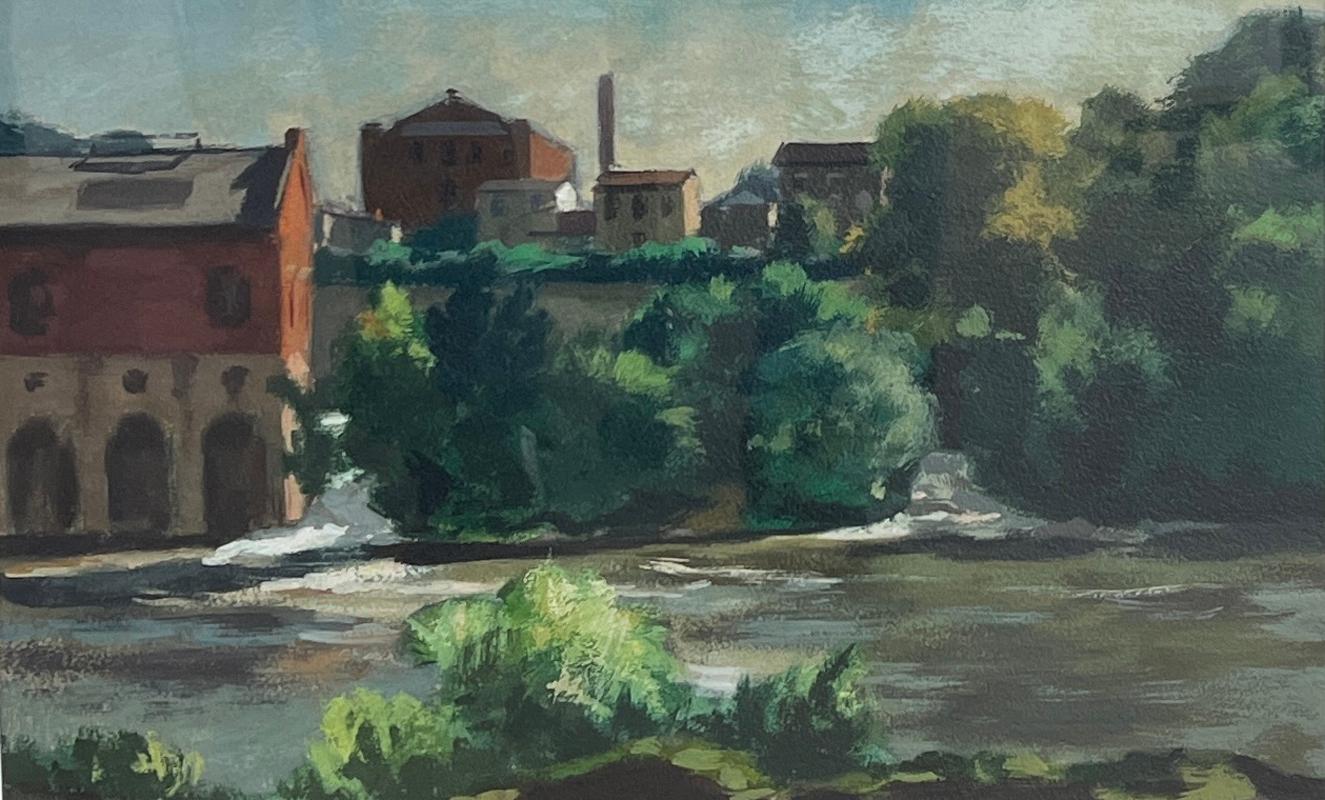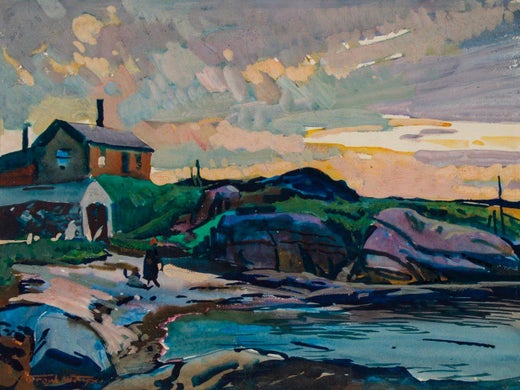Items Similar to Venetian Canal
Want more images or videos?
Request additional images or videos from the seller
1 of 8
Frank WilcoxVenetian Canalc. 1910-11
c. 1910-11
About the Item
Venetian Canal, c. 1910-11
Tempera on board
Frank Nelson Wilcox (October 3, 1887 – April 17, 1964) was a modernist American artist and a master of watercolor. Wilcox is described as the "Dean of Cleveland School painters". In 1906 Wilcox enrolled from the Cleveland School of Art under the tutelage of Henry Keller, Louis Rorimer, and Frederick Gottwald. He also attended Keller's Berlin Heights summer school from 1909. After graduating in 1910, Wilcox traveled and studied in Europe, sometimes dropping by Académie Colarossi in the evening to sketch the model or the other students at their easels, where he was influenced by French impressionism. Wilcox was influenced by Keller's innovative watercolor techniques, and from 1910 to 1916 they experimented together with impressionism and post-impressionism. Wilcox soon developed his own signature style in the American Scene or Regionalist tradition of the early 20th century. He joined the Cleveland School of Art faculty in 1913. Among his students were Lawrence Edwin Blazey, Carl Gaertner, Paul Travis, and Charles E. Burchfield. Around this time Wilcox became associated with Cowan Pottery.
- Creator:Frank Wilcox (1887 - 1964, American)
- Creation Year:c. 1910-11
- Dimensions:Height: 24 in (60.96 cm)Width: 30 in (76.2 cm)
- Medium:
- Movement & Style:
- Period:
- Condition:
- Gallery Location:Beachwood, OH
- Reference Number:1stDibs: LU176829625112
Frank Wilcox
Frank Nelson Wilcox (October 3, 1887 – April 17, 1964) was a modernist American artist and a master of watercolor. Wilcox is described as the "Dean of Cleveland School painters," though some sources give this appellation to Henry Keller or Frederick Gottwald. Wilcox was born on October 3, 1887 to Frank Nelson Wilcox, Sr. and Jessie Fremont Snow Wilcox at 61 Linwood Street in Cleveland, Ohio. His father, a prominent lawyer, died at home in 1904 shortly before Wilcox' 17th birthday. His brother, lawyer and publisher Owen N. Wilcox, was president of the Gates Legal Publishing Company or The Gates Press. His sister Ruth Wilcox was a respected librarian. In 1906 Wilcox enrolled from the Cleveland School of Art under the tutelage of Henry Keller, Louis Rorimer, and Frederick Gottwald. He also attended Keller's Berlin Heights summer school from 1909. After graduating in 1910, Wilcox traveled and studied in Europe, sometimes dropping by Académie Colarossi in the evening to sketch the model or the other students at their easels, where he was influenced by French impressionism. Wilcox was influenced by Keller's innovative watercolor techniques, and from 1910 to 1916 they experimented together with impressionism and post-impressionism. Wilcox soon developed his own signature style in the American Scene or Regionalist tradition of the early 20th century. He joined the Cleveland School of Art faculty in 1913. Among his students were Lawrence Edwin Blazey, Carl Gaertner, Paul Travis, and Charles E. Burchfield. Around this time Wilcox became associated with Cowan Pottery. In 1916 Wilcox married fellow artist Florence Bard, and they spent most of their honeymoon painting in Berlin Heights with Keller. They had one daughter, Mary. In 1918 he joined the Cleveland Society of Artists, a conservative counter to the Bohemian Kokoon Arts Club, and would later serve as its president. He also began teaching night school at the John Huntington Polytechnic Institute at this time, and taught briefly at Baldwin-Wallace College. Wilcox displayed over 250 works at Cleveland's annual May Show. He received numerous awards, including the Penton Medal for as The Omnibus, Paris (1920), Fish Tug on Lake Erie (1921), Blacksmith Shop (1922), and The Gravel Pit (1922). Other paintings include The Trailing Fog (1929), Under the Big Top (1930), and Ohio Landscape (1932). Wilcox died on April 17, 1964, having taught at the Cleveland School of Art (now Cleveland Institute of Art or CIA) for over 40 years. Today CIA awards an annual scholarship prize in his name to students majoring in printmaking.
About the Seller
No Reviews Yet
Vetted Seller
These experienced sellers undergo a comprehensive evaluation by our team of in-house experts.
Established in 1975
1stDibs seller since 2022
9 sales on 1stDibs
Typical response time: 10 hours
- ShippingRetrieving quote...Ships From: Beachwood, OH
- Return PolicyA return for this item may be initiated within 14 days of delivery.
More From This SellerView All
- Ohio Countryside, 20th century farm landscape, Cleveland School ArtistBy George AdomeitLocated in Beachwood, OHGeorge Gustav Adomeit (American, 1879-1967) Ohio Countryside Oil on artist's board 16 x 20 inches 21.5 x 25.5 inches, framed A major painter of American scene subjects, George Adome...Category
20th Century American Modern Figurative Paintings
MaterialsOil
- Coastal Scene, 20th Century Seascape, Cleveland School ArtistBy George AdomeitLocated in Beachwood, OHGeorge Gustav Adomeit (American, 1879-1967) Coastal Scene Oil on canvas Signed lower left 19 x 23 inches 21.5 x 25.5 inches, framed A major painter of American scene subjects, Georg...Category
20th Century American Modern Figurative Paintings
MaterialsOil
- Schooner, Boothbay Harbor, Maine, Early 20th Century Seascape WatercolorBy Frank WilcoxLocated in Beachwood, OHFrank Nelson Wilcox (American, 1887-1964) Schooner, Boothbay Harbor, Maine, c. 1924 Gouache and watercolor on paper Signed lower right 14 x 20 inches 19.5 x 25.5 inches, as framed Frank Nelson Wilcox (October 3, 1887 – April 17, 1964) was a modernist American artist and a master of watercolor. Wilcox is described as the "Dean of Cleveland School painters," though some sources give this appellation to Henry Keller or Frederick Gottwald. Wilcox was born on October 3, 1887 to Frank Nelson Wilcox, Sr. and Jessie Fremont Snow Wilcox at 61 Linwood Street in Cleveland, Ohio. His father, a prominent lawyer, died at home in 1904 shortly before Wilcox' 17th birthday. His brother, lawyer and publisher Owen N. Wilcox, was president of the Gates Legal Publishing Company or The Gates Press. His sister Ruth Wilcox...Category
1920s American Modern Landscape Drawings and Watercolors
MaterialsGouache, Watercolor
- Boothbay Harbor, Maine Dock Seascape, Early 20th Century, Cleveland SchoolBy George AdomeitLocated in Beachwood, OHGeorge Gustav Adomeit (American, 1879-1967) Boothbay Harbor, 1924 Oil on canvas Signed lower right 15 x 17 inches 20.25 x 22.25 inches, framed A major painter of American scene subj...Category
1920s American Modern Figurative Paintings
MaterialsOil
- Early 20th Century Summer Landscape, Cleveland School ArtistBy George AdomeitLocated in Beachwood, OHGeorge Gustav Adomeit (American, 1879-1967) Summer Landscape Oil on canvas board Signed lower right 13 x 14.25 inches 18.25 x 19.5 inches, framed A major painter of American scene s...Category
Early 20th Century American Modern Figurative Paintings
MaterialsOil
- Hillside and Stream, early 20th century modernist Cleveland School paintingLocated in Beachwood, OHClara Deike (American, 1881-1964) Hillside and Stream, 1916 Gouache on paper Signed and dated lower right 22 x 18 inches 25.5 x 21.5 inches, framed A graduate of the Cleveland Schoo...Category
1910s American Modern Figurative Paintings
MaterialsGouache
You May Also Like
- Bird in CageLocated in New York, NYGouache on board, 20 x 24 in. Signed (at lower right): Atherton Painted about 1940 RECORDED: Art News (May 11, 1940), illus. [clipping citation] EXHIBITED: The Art Institute of Chicago, 1940, The International Watercolor Exhibition, no. 156, illus. on cover as Bird in Cage...Category
Mid-20th Century American Modern Landscape Paintings
MaterialsTempera, Wood Panel
- Missouri FarmBy Roger MedearisLocated in New York, NYSigned lower left: MEDEARIS; on verso: MISSOURI FARM / 16” x 24” / PAINTED IN EGG TEMPERA / (WITH ACRYLIC POLYMER EMULSION) / PAINTED ON HARDBOARD PANEL WHICH HAS / BEEN COATED WITH ...Category
20th Century American Modern Landscape Paintings
MaterialsTempera
- The Carved Door, Semi-Abstract Tempera Landscape Painting with Flora and FaunaBy Archie MusickLocated in Denver, COTempera on board painting titled 'The Carved Door' by Archie Musick, signed by the artist in the lower right corner. Depicts a semi-abstract landscape with flora and fauna. Presented...Category
Mid-20th Century American Modern Landscape Paintings
MaterialsBoard, Tempera
- The Lonely Road by William Charles PalmerLocated in Hudson, NYThe Lonely Road (1940) Tempera on panel 12" x 16" 19 1/2" x 23 1/2" x 1 1/2" framed Hand-signed "Palmer '40" lower center. Provenance: Midtown Galleries, New York, NY (labels verso...Category
Mid-20th Century American Modern Figurative Paintings
MaterialsPanel, Tempera
- Spring Storm, Modernist Southwestern New Mexico Landscape Casein PaintingBy Doel ReedLocated in Denver, COSpring Storm, original vintage painting by New Mexico & Oklahoma modernist, Doel Reed (1894-1985). Evening scene with hint of a moon, clouds and rain over a rocky western landscape with low mountains/buttes, dated, June 1980 and signed by the artist lower right. Presented in a custom frame, outer dimensions measure 24 ½ x 37 ½ x 1 ¼ inches. Image size is 14 ¾ x 27 ¾ inches. Provenance: Private Collection, Denver, Colorado Expedited and international shipping is available - please contact us for a quote. About the Artist: Early in his artistic career, Doel Reed knew he wanted to be a printmaker. Influenced by Goya's aquatints, he extended himself beyond his formal art training to learn this technique, and he established himself as one of its masters. For decades, he devoted himself to the art program at the University of Oklahoma, taking it from a faculty of one to a major mid-Western department. Upon retirement, Reed focused totally on his work, moving with his family to Taos, New Mexico, where they had previously summered. Marked by strong tonal contrasts, his landscapes of this region are deeply emotional renderings with a sense of mystery -- modernist forms combined with romantic moodiness. Born and raised in Indiana, Reed originally studied architecture, which he credits with a lifelong attention to "how something is constructed." His mature style can be characterized as architectonic in his concern with assembling volumes and planes. Even the intense northern New Mexico light becomes the means to articulate three-dimensional patterns into cubistic interplay. When painting, Reed used thick strokes of oil and casein as another structural element. Transferring to fine art, his studies at the Cincinnati Art Academy were then interrupted by military service in World War I. Suffering a gas attack in the trenches of France, Reed spent months in a hospital temporarily blinded. The effects of the gas also damaged his lungs, which later prompted him to live in the dry climates of Oklahoma and New Mexico. After the war, he returned to his studies, but it was discovery of Goya's aquatints rather than his art classes that inspired. Considered the master, Goya drew on the tonal range available with this medium to create powerfully haunting imagery. Perhaps Reed responded personally to the eloquent series "The Disasters of War." Now his course was set, and he built his own etching press, which he continued to use for the rest of his life. In 1924, he accepted a teaching position at Oklahoma State University, where he remained for thirty-five years. Emphasizing drawing, Reed encouraged students to go to nature and translate the scene through their own sensibilities. Beginning as the sole art professor, he developed the program when it became an independent department in 1930. Through his stewardship, the university gained a reputation as one of the best for printmaking in the country. During the forties, Reed also prepared a series of lectures and demonstrations on aquatint for the Association of American Colleges. His most public offering in art education is the book "Doel Reed Makes An Aquatint" (1965). Sabbaticals allowed him to visit Paris in 1926 and 1930-31. Summer travel took him to Nova Scotia and Mexico, but gas rationing during World War II necessitated a closer destination. Thus the Reed connection with Taos was established. Finally in 1959, he, his wife, and daughter moved there to Talpa Ridge, the same outlying area in which artists like Andrew Dasburg, Howard Cook, and Barbara Latham resided. Settling into a complex of three adobe buildings, Reed was welcomed by these artists, who referred to their community as Neurosis Ridge. Rena Rosenquist of Mission Gallery remembers that Reed was "the most affable man" who liked cold martinis. For Reed, the surrounding Sangre de Cristo Mountains offered "end of abstract pattern." His inventive mind came up with techniques to transform a natural scene into a richly dimensional object. He fashioned a rosin box and concocted his own formula of etching ground to achieve a velvety texture with his prints. Described as "not for the faint-hearted,”" casein became a medium with which built up paint surfaces that almost seem sculpted. Both the prints and drawings are characterized by a tension between the two-dimensional surface pattern and the articulated space it conveys. In addition to landscapes, Reed produced a number of works of voluptuous women with the figures echoing landscape elements. As a boy, his first art experience was a grade-school field trip to the John Herron Art Museum (now the Indianapolis Art Museum), where he expressed his admiration for a painting of a nude mermaid -- an image that made a lasting impression. Reed was proudest of his recognition by the National Academy of Design (now just the National Academy). In 1942, he was named associate member; in 1952, he was named full academician. ©David Cook Galleries, LLC Exhibited: Society of Independent Artists, 1927 & 1929; Society of American Etchers, 1930-1946; Kansas City Art Institute, 1932; “100 Etchings of Year,” 1932-44; Art Institute of Chicago, 1934, 1937, 1939; National Academy of Design, 1934-46, 1965 (Samuel Morse Medal); Tulsa Art Association, 1935 (prize); Paris Salon, 1937; Rome, Italy, 1937; Sweden, 1938; Chicago Society of Etchers, 1938 (prize); Corcoran Gallery of Art, Washington, D.C., 1940; Philadelphia Print Club, 1940 (prize); Venice, Italy, 1940; Carnegie Institute, 1941; Currier Gallery of Art, Manchester, NH,1942, (prize); Metropolitan Museum of Art, 1942; Whitney Museum of American Art, 1942; Northwest Printmakers, 1942 (prize), 1944 (prize); Herron Art Institute, 1943; Library of Congress, 1944-46; Pennsylvania Academy of the Fine Arts, 1944-45; Philbrook Art Club, 1944 (prize); Laguna Beach Art Association, 1944 (prize); Southern States Art League, 1944 (prize); “50 American Prints,” 1944; Oakland Art Gallery, 1945 (prize); Audubon Artists, 1945, 1951 (Gold Medal of Honor), 1954 (John Taylor Arms Memorial Medal); Albany Institute of History and Art, 1945; Pasadena Art Institute, 1946; London; Allied Art Association; National Society of Painters Casein; Mission Gallery, Taos, NM, and Blair Galleries, Ltd. Santa Fe, NM. Works Held: Carnegie Institute; Honolulu Academy of Art; Grinnell College; Library of Congress; Metropolitan Museum of Art; Museum of Fine Art, Houston; New York Public Library; Oklahoma Art Club; Pennsylvania Academy of Fine Art; Philadelphia Museum of Art; Philbrook Art Club; Seattle Art Museum; Southern Methodist University; University of Montana; University of Tulsa; Bibliotéque Nationale, Paris; Victoria and Albert Museum, London. Further Reading: Harmsen's Western Americana: A Collection of One-Hundred Western Paintings with Biographical Profiles of the Artists, Dorothy Harmsen, Northland Press, Flagstaff, Arizona, 1971.; The Illustrated Biographical Encyclopedia of Artists of the American West, Peggy and Harold Samuels, Doubleday & Company, Inc., Garden City, New York, 1976.; Taos Artists...Category
1980s American Modern Landscape Paintings
MaterialsCasein, Archival Paper
- Manayunk, Schuylkill River, Factory, City Scene Philadelphia, Pennsylvania 1970By Giovanni MartinoLocated in Rancho Santa Fe, CAProvenance: Private Collection, San Diego, CA. Framed Giovanni Martino, National Academy of Design* member, was born on May 1, 1908 in Philadelphia PA where all seven brothers and one sister, Filomina, Frank, Antonio, Albert, Ernest, Giovanni, Edmond, and William became painters. They were under the tutelage of their eldest brother, Frank, who in the late 1920s, founded the first commercial art* studio, Martino Studios, at 27 South 18th Street. Besides studying with his two eldest brothers, Giovanni also studied with Albert Jean Adolph at La France Institute, The Pennsylvania Academy of the Fine Arts*, The Graphic Sketch Club, and Spring Garden Institute in Philadelphia. In his mid teens he accompanied his two eldest brothers to New Hope searching for subjects to paint. In the 1930s, he also started to paint in Manayunk, a hilly mill town along the Schuylkill River. At this time he signed his paintings M. Giovanni. These colorful impressionistic* works proceeded more thinly painted dramatically poetic street scenes of the mill town. These images developed into impasto* laden oils in the 1960's with some of the paintings worked with a palette knife*. In Manayunk, he was a common sight on the streets and sidewalks, painting on-the-spot with his wife, Eva Marinelli and his two daughters, Nina & Babette. In the 1980's and 90's he also painted in Conshohocken and Norristown with his youngest daughter, Babette. His paintings became more sharply executed like his earlier work but were more colorful. In the late '90's he worked in his studio to enlarge paintings. He is the recipient of over 100 awards and honors. He received the Benjamin Altman Prize in Landscape Painting in 1975 at the National Academy of Design, NYC where he was elected an Academician (NA) in 1944. He mentored not only his wife and two daughters but also taught at Lehigh University and the Graphic Sketch Club, Philadelphia. He died at his home in Blue Bell on February 1, 1997. (Babette Martino...Category
1970s American Modern Landscape Paintings
MaterialsMixed Media, Paper, Oil, Tempera
Recently Viewed
View AllMore Ways To Browse
By Venetian
Venetian Antique
Antique Venetian
Venetian Art
Venetian Frames
Venetian Master
Venetian Scene
American Antique Pottery
Antique American Pottery
Antique Art Easels
Antique Art Easel
Cleveland Antique
Antique French Easel
Antique Artists Easel
Antique Artist Easel Antiques
Antique Artist Easel Easels
Antique Artist Easel
Antique Artists Easel Antiques
